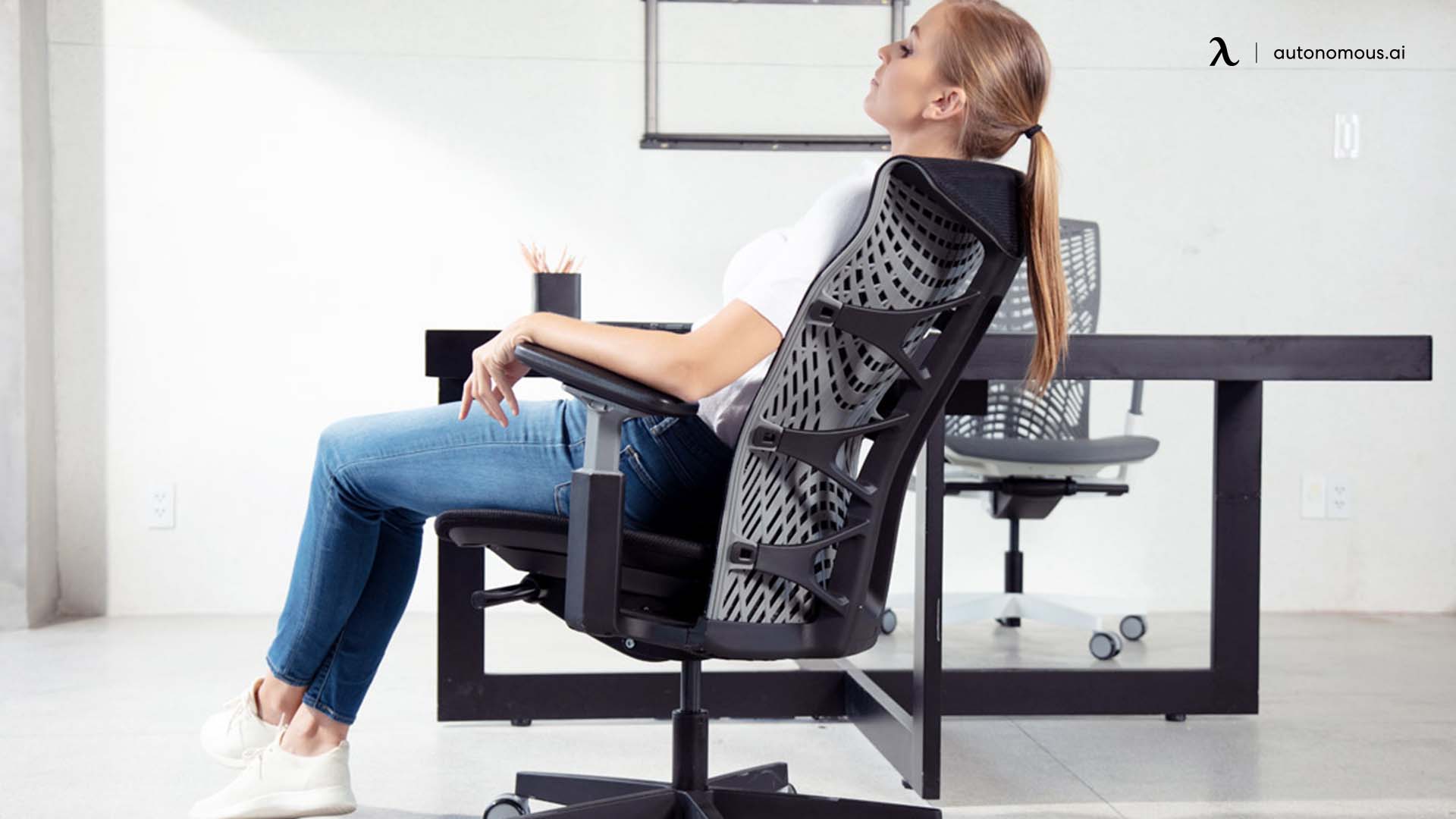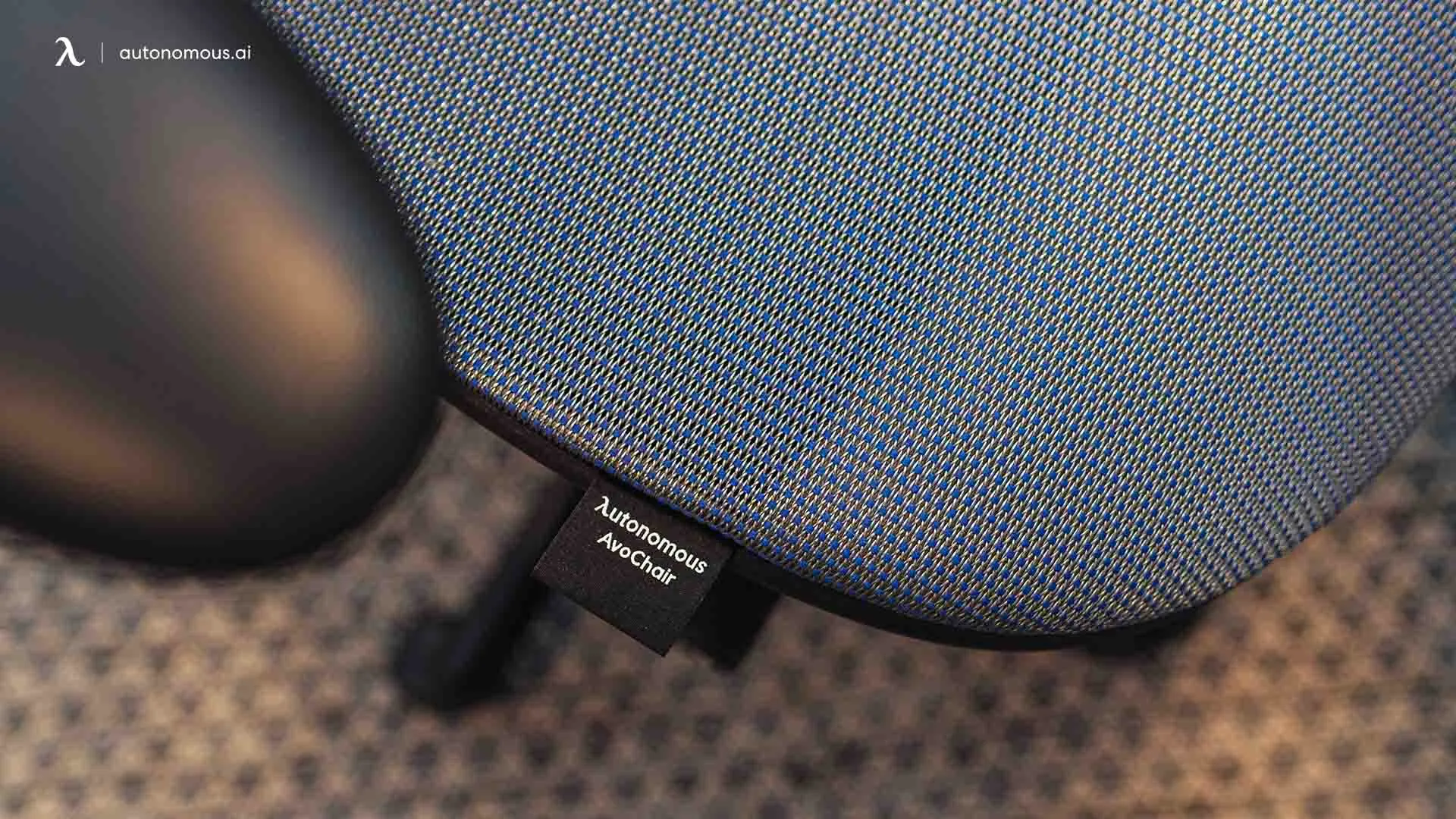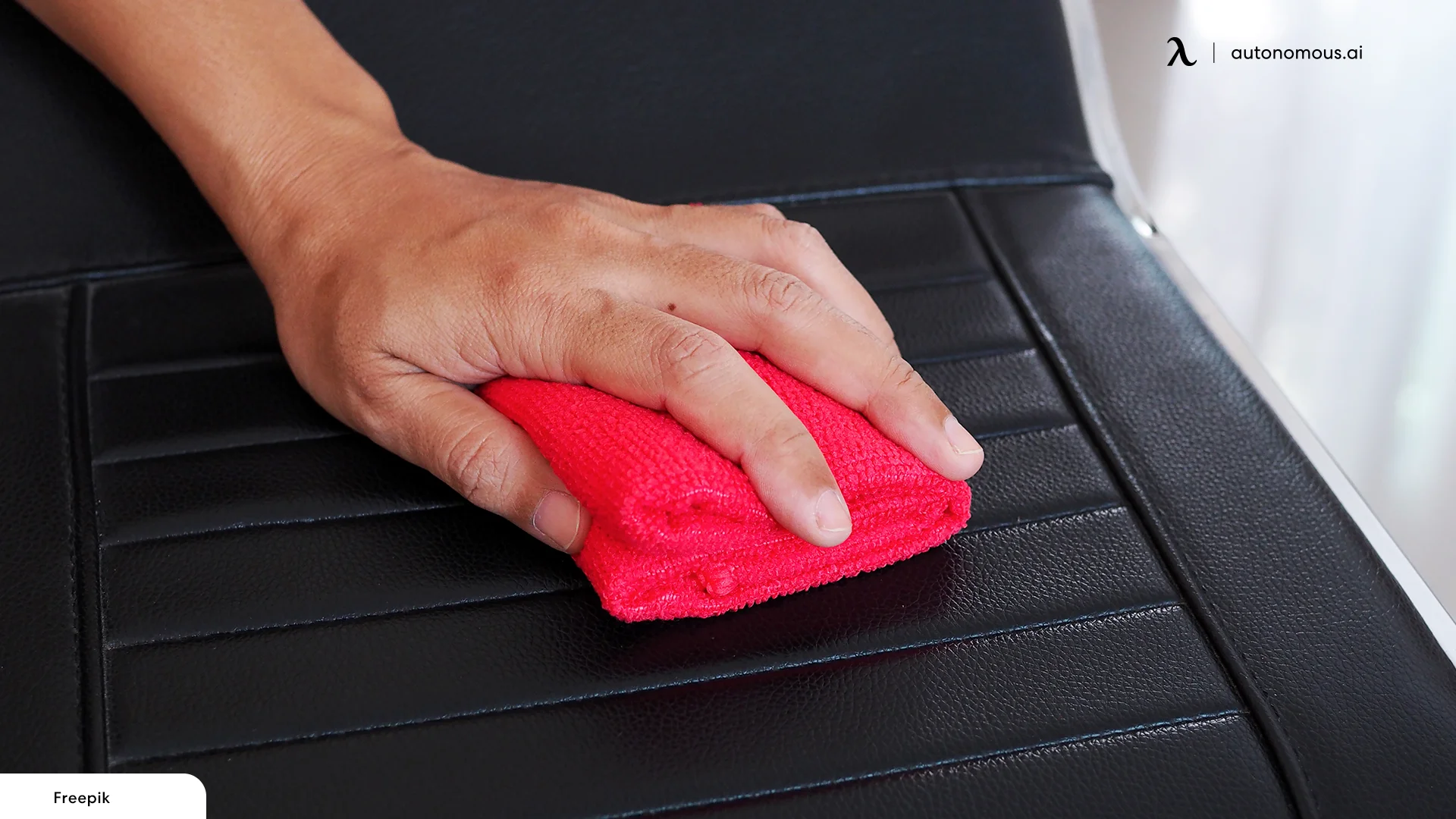
15 Easy Ways and Ideas to Deodorize Your Office Chair
Table of Contents
- Always Check The Care Tag First
- 15 Ways to Remove Odors from Your Office Chair
- 3. Vacuum Every Surface
- 4. Apply Baking Soda
- 5. Rub With A Dryer Sheet
- 6. Use A Steam Cleaner (If Safe)
- 7. Treat With White Vinegar Solution
- 8. Spot Clean With Rubbing Alcohol
- 9. Use Leather Conditioner (For Leather Chairs)
- 10. Spray With A Fabric-Safe Commercial Cleaner
- 11. Apply A Dry-Cleaning Solvent
- 12. Deep Clean With Soap And Water
- 13. Spray With Febreze Or A Fabric Deodorizer
- 14. Hire A Professional Cleaning Service
- 15. Buy a New Chair
- FAQs
- Conclusion
Let’s face it — office chairs work hard. From long hours at your desk to the occasional lunch break snack, they absorb more than just pressure. Whether it’s a brand-new seat or a well-used one, learning how to clean an office chair smell effectively can make your workspace feel fresher and more inviting.
Understanding how to clean an office chair smell can help you refresh your workspace, improve hygiene, and extend the life of your chair. In this guide, we’ll walk through 15 practical ways to remove odor from office chairs, from natural remedies to deep cleaning methods.
Always Check The Care Tag First
Wondering how to clean an office chair smell without damaging the fabric or foam? The answer depends on your chair’s material, how long it's been in use, and where the odor is coming from.
It’s essential to check your chair’s cleaning code. This ensures you don’t damage your office chair material while trying to understand how to clean an office chair smell.
Most chairs have a tag built into them or plastered onto them, which includes the care instructions. Some chairs also come with instruction manuals or brochures.
Typically, a tag will have a letter code to tell you how to care for your chair. These codes are:
- W – Use water-based cleaners.
- S – Use solvent-based cleaners only (no water).
- WS or SW – Both water- and solvent-based cleaners are fine.
- X – Do not clean yourself; professional only.
- C – Crypton fabric; follow specific manufacturer guidelines.
Misusing products can damage your upholstery or padding — always check before you clean. If you’re using the wrong ingredients to clean the office chair, your office chair color may be changed as well, so it’s a must-have step in how to clean a smelly chair.

15 Ways To Clean An Office Chair Smell
From sun exposure to steam cleaning, learning how to clean an office chair smell gives you control over your workspace's freshness. Here’s how to do that:
1. Let It Air Out Naturally
Best for: New chairs with that “factory smell.”
Many brand-new chairs release what's known as off-gassing — a harmless but unpleasant smell from the foam and plastic components. Set up your new chair in a well-ventilated room or near an open window. I like to place mine near a fan to improve airflow. Let it sit for at least 48–72 hours.
This is the simplest way to start learning how to clean an office chair smell right after unboxing.
My tip: Avoid placing it in a small, enclosed room like a closet — it’ll only trap the smell longer.
2. Sunlight Treatment
Best for: Mild odor buildup and damp smells.
Sunlight is nature’s disinfectant. Place your chair outside in direct sunlight for 2–4 hours. UV rays help kill bacteria and neutralize organic smells (think food spills or body odors). If the smell is stronger, leave it out for a full day, but bring it inside before dusk to avoid dew or moisture.
This is especially helpful when you're figuring out how to get rid of the smell in office chairs with fabric cushions.
My tip: Rotate the chair halfway through the day to expose all sides evenly. Don’t leave leather or mesh chairs out too long — UV can degrade these materials.
Now, you don’t need to leave it in the sun for long. A few hours or a few days is plenty. As long as your chair gets the full brightness of the sun (not filtered through UV-blocking glass), it should be able to break down a lot of the nastiness that causes odors.
3. Vacuum Every Surface
Best for: Dust, food crumbs, and odor-trapping particles.
Understanding how to remove smell from office chair cushions includes regular vacuuming and airing out after spills or sweaty days. Odors often linger where particles settle, especially food and skin cells. We’re not just talking about that lost M&M that slipped in the cracks; we mean dust and other particulates that accumulate in the air, on every surface, and everywhere else.
You may need to go over the chair more than once, depending on the strength of your vacuum and the length of time since you last cleaned your chair. This alone won’t entirely deodorize a chair, but it’s a good start to help with any cleaning you’ll do later.
My tip: Don’t forget the underside of the chair and around armrests. If your vacuum has a HEPA filter, even better — it traps allergens while you clean.
If your chair is mesh, cleaning requires a slightly different approach. Here's a step-by-step guide on how to clean a mesh chair properly without damaging the material.
4. Apply Baking Soda
Best for: Neutralizing odors from fabric and foam.
One of the easiest ways to remove smell from office chair fabric is by using baking soda overnight.
Baking soda is one of the most powerful household cleaners available without going out of your way to pick up a nasty chemical.
- It chemically reacts with odor-causing compounds to break them down.
- It’s mildly abrasive and works extremely well as a scouring paste.
- It can react with vinegar for further cleaning power.
Take your chair out somewhere you won’t make a mess and sprinkle baking soda liberally over the chair surface you want to deodorize. Sprinkle baking soda over the entire seat and backrest — especially in creases and where your body touches the most. Let it sit for 8–12 hours (overnight is perfect). Then vacuum thoroughly.
If you’re working with a fabric office chair, baking soda is especially effective for lifting odors from the woven surface and foam padding underneath.
My tip: Use a mesh strainer to distribute the baking soda evenly. If you want an extra boost, mix a few drops of essential oil (like lavender or tea tree) into the powder before sprinkling.
5. Rub With A Dryer Sheet
Best for: Quick refreshes and surface-level smells.
Dryer sheets are essentially just thin layers of fabric coated with a fabric softener compound. This compound is what helps soften clothes and linens when you run them through a dryer, and can leave them smelling great as well.
Take a fresh dryer sheet and rub it across the seat, backrest, and arms. It leaves a light fragrance behind and helps reduce static. This is a great between-cleaning trick when guests are coming over or before a meeting. It leaves behind a pleasant scent, though it won’t fix deep odors. Still, it helps if you’re learning how to clean a smelly chair on short notice.
My tip: Tuck a dryer sheet under the seat cushion or behind the backrest for a longer-lasting scent boost.
6. Use A Steam Cleaner (If Safe)
Best for: Deep-cleaning fabric chairs.
If you're wondering how to clean a smelly chair deeply and safely, a steam cleaner is your best friend. Steam cleaners use hot vapor to kill bacteria and loosen grime deep in the fabric. Steam cleaners use heated water to infuse a surface with hot moisture, and then use suction to pull it back out, taking dirt, grime, and odor-causing compounds right back out.
Simply use a handheld model with an upholstery attachment, and go slowly. Work in small sections, and don’t oversaturate. This combination is powerful for cleaning upholstery and fabrics, but you have to make sure your chair won’t be ruined by water.
My tip: Always do a patch test on an inconspicuous area. Let the chair air-dry completely — ideally by a window or with a fan nearby to speed up drying time.
If the smell is coming from underneath or around the wheels, it may help to learn how to remove the office chair base for better access to hidden debris.

7. Treat With White Vinegar Solution
Best for: Stubborn food, sweat, or mildew odors.
Along with sunlight and baking soda, vinegar is also a great DIY option for anyone looking for how to remove the smell from office chair surfaces naturally. It can eat away at particles and compounds that cause odors, and will get rid of them surprisingly quickly.
It’s best to do this in a ventilated room, during off-hours, or outside (to let the sun help). Mix equal parts white vinegar and water in a spray bottle. Lightly mist over affected areas, but don’t soak them. Let the chair air-dry in a well-ventilated space. The vinegar smell fades as it dries, taking other odors with it.
My tip: Avoid mixing vinegar with baking soda at the same time — they react and lose effectiveness. Alternate methods if using both.
8. Spot Clean With Rubbing Alcohol
Best for: Sanitizing and breaking down organic smells (sweat, bacteria).
Rubbing alcohol as a cleaner is a little more powerful than vinegar, and has a stronger and longer-lasting odor itself. It will still help denature any organic particles and some chemicals that cause odors, and it will evaporate itself and leave no odor behind.
Simply dip a clean cloth or cotton ball in rubbing alcohol and gently dab or rub areas with strong odors. It evaporates quickly and helps disinfect the fabric or foam underneath.
My tip: For deep-seated odors, press into the fabric with a sponge soaked in rubbing alcohol. Odors tend to settle deeper in a thick cushion office chair, so be sure to press your cleaning solution deep into the foam and give it time to absorb. Always use this in a well-ventilated space.
9. Use Leather Conditioner (For Leather Chairs)
Best for: Restoring and deodorizing leather surfaces.
Leather tends to resist odors better than fabric, but if you still notice lingering scents, conditioning is a great way to keep office chairs from smelling while maintaining their look. Leather requires its own routine when learning how to clean a smelly chair without drying or damaging the surface.
Clean the surface first with a damp cloth, then apply a leather conditioner according to the product directions. It hydrates the leather and leaves a pleasant scent.
My tip: Avoid DIY hacks on leather — stick to conditioners recommended by the manufacturer to prevent discoloration or damage.
Mesh materials tend to air out faster than upholstered ones, making them a great choice if odor resistance is a concern. If you're in the market, consider investing in a breathable and easy-to-clean mesh office chair.

10. Spray With A Fabric-Safe Commercial Cleaner
Best for: Tough or lingering smells that home remedies don’t touch.
Commercial chemicals – just cleaning products you buy from the store – are usually carefully engineered solvents mixed with water to allow them to penetrate surfaces. Pick an upholstery-safe cleaner like Resolve, Woolite, Bissell Resolve, Scotchgard, and more.
Spray lightly on the seat and backrest. Let it sit for the recommended time, then blot with a clean cloth.
My tip: Enzyme-based sprays work best for organic odors, and they’re especially helpful when learning how to clean smelly office chairs that have been through a lot.
11. Apply A Dry-Cleaning Solvent
Best for: Chairs marked with “S” or “X” (no water allowed).
For chairs that cannot use water or water-based cleaners, you’ll want what is known as a dry-cleaning solvent. Dry-cleaning solvents like perchloroethylene are powerful and evaporate quickly. Lightly apply using a clean cloth and dab problem areas. Do this outdoors or in a well-ventilated space.
It’s a reliable approach for people trying to understand how to remove the smell from office chairs without water.
My tip: Always wear gloves and follow safety directions. If you’re unsure, consider testing in a hidden spot first or consulting a professional.
When cleaning a fabric upholstered office chair, always double-check the tag for water safety—some may require solvent-only care.
12. Deep Clean With Soap And Water
Best for: Fabric chairs that allow water.
Mix a few drops of mild dish soap in warm water. Dip a soft cloth or sponge, wring it out, and scrub the chair gently. Press down to work into the foam, then blot with a dry towel to extract moisture. Repeat this process until the water being released from the chair is relatively clean and clear.
From there, press on the cushion with your absorbent material to remove as much moisture as you can get out of it, then let it air-dry for a day or two afterward. This should remove the majority of whatever is causing odors, leaving your chair fresh and clean.
My tip: Use microfiber towels — they’re more absorbent and gentler on fabric. Let your chair dry for at least 24 hours before using it again.
If you own an office chair with a cushion, deep cleaning the padding regularly is key to keeping smells at bay.
13. Spray With Febreze Or A Fabric Deodorizer
Best for: Masking light odors short-term.
Febreze is a brand of deodorizing product that doesn’t do much to address the cause of odors but does cover them up quite well. Lightly mist the seat and back with Febreze or another upholstery-safe deodorizer. It won’t remove the source of the smell, but it does freshen the surface.
My tip: Choose a neutral scent if you’re using it in a shared space or office — strong fragrances can be polarizing.
For a more thorough clean, you might consider partial disassembly. Here’s a simple guide on how to disassemble an office chair without damaging any components.
14. Hire A Professional Cleaning Service
Best for: Valuable chairs or when nothing else works.
If your chair is labeled “X” or you’re worried about damaging it, professional upholstery cleaners have the right tools and solvents. They can clean deeper than a home machine and remove stubborn smells completely.
My tip: If your chair was a big investment or part of a set, this route protects your warranty and prolongs its life.
15. Buy a New Chair
Best for: Chairs that are old, badly stained, or structurally worn out.
Sometimes, it's just time. Sometimes, it's just time. If all else fails and you’re still unsure how to remove the smell from office chair foam, it might be time to replace the chair.
My tip: Look for a new chair made with breathable mesh, removable fabric covers, or odor-resistant materials — they’re much easier to clean and maintain.

FAQs
1. How often should I deodorize my office chair?
About once every 1–2 months, or anytime you notice odors. Vacuuming weekly can help prevent smells from building up.
2. Why does my office chair smell bad even after cleaning?
The smell may be coming from deep within the foam or padding. A steam cleaner or professional service can help remove odors embedded below the surface.
3. How do you get the smell out of office chairs?
Start by vacuuming the chair thoroughly, then sprinkle baking soda over the fabric and let it sit overnight. For deeper odors, use a vinegar-water spray, steam cleaner, or an upholstery-safe commercial cleaner. If the smell is still there, sun exposure or a professional cleaning service can help remove stubborn odors.
4. How do you get the smell out of an upholstered chair?
Vacuum first to remove dust and particles. Then apply baking soda or an enzyme-based fabric cleaner, depending on the source of the smell. Steam cleaning is especially effective for fabric chairs, as it lifts out bacteria and odor from deep in the foam. Always let it dry completely in a well-ventilated area.
5. How do you deep clean an office chair seat?
If your chair is safe for water, use a mild soap and warm water solution with a sponge or soft-bristle brush. Scrub gently to lift stains and odor-causing residue from the seat. Blot excess water with a towel and repeat until the water runs clear. Finish by letting it air-dry completely.
For non-water-safe chairs, opt for solvent-based or dry-cleaning products.
Don’t forget to clean your casters too—hair and dust buildup there can trap odors and cause drag. Here’s how to remove hair stuck in your office chair wheels the easy way.
6. How do you get the BO smell out of plastic chairs?
Plastic surfaces can absorb sweat and oils over time. Wipe down the chair with a mixture of rubbing alcohol and water (50/50 ratio) or undiluted white vinegar. Let it dry in the sun afterward for extra deodorizing power. For strong odors, repeat the process and focus on textured or grooved areas where sweat may settle.
7. How do I keep my office chair from smelling long-term?
Vacuum weekly, treat stains quickly, and deodorize monthly with baking soda or vinegar spray. Breathable materials help keep office chairs from smelling between deep cleans.
8. What’s the best way to remove odor from office chairs without chemicals?
Sunlight, baking soda, and white vinegar are great natural options to remove odor from office chairs effectively.
Conclusion
Smells may be subtle, but they can impact how you feel in your workspace. Learning how to clean an office chair smell means creating a space that supports clarity, comfort, and confidence — and that’s what a good workspace is all about.
Whether it’s a natural deodorizer or a deep-cleaning session, the key is to be consistent and aware of what your chair’s materials can handle. Once your chair smells fresh again, why not take a moment to improve your sitting experience? These tips on how to make an office chair more comfortable can help you turn it into a productivity powerhouse.
Stay connected with us!
Subscribe to our weekly updates to stay in the loop about our latest innovations and community news!
Interested in a Link Placement?
.svg)


.webp)







.webp)

